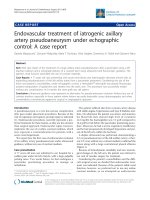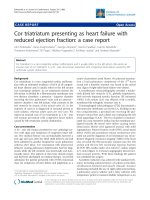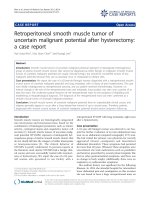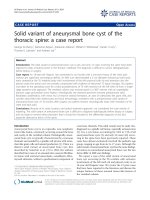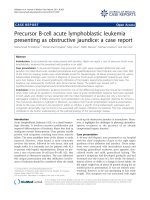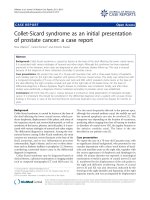Báo cáo y học: " ectopic pelvic kidney following blunt trauma to the lower abdomen: a case report" pdf
Bạn đang xem bản rút gọn của tài liệu. Xem và tải ngay bản đầy đủ của tài liệu tại đây (586.63 KB, 3 trang )
CAS E REP O R T Open Access
Conservative management of a grade V injury to
an ectopic pelvic kidney following blunt trauma
to the lower abdomen: a case report
Aaron B Becker
*
, Mirza B Baig, Adam M Becker
Abstract
Introduction: Ectopic pelvic kidneys represent an anatomic variant that remains clinically asymptomatic in most
patients. While there is some literature to suggest that ectopic kidneys may be more predisposed to blunt trauma
injuries, there are few examples to guide the management of these injuries. To our knowledge, we present the first
case of a grade V renal injury to an ectopic pelvic kidney managed successfully with conservative measures.
Case Presentation: We present a case of grade V renal injury to an ectopic pelvic kidney in a 21 year-old African-
American male. The clinical and radiographic findings are presented, along with the patient’s conservative hospital
course.
Conclusion: We suggest that management of grade V renal injuries to ectopic pelvic kidneys can be treated
similarly to that of kidneys in normal anatomic position. Conservative measures may be considered in properly
selected patients.
Introduction
Ectopic p elvic kidneys occur with a reported incidence
of between 1 in 500 to 1 in 1200. Although pelvic kid-
neys are associated with anomalies including hydrone-
phrosis and vesicoureteral reflux, most are clinically
asymptomatic [1]. Pelvic kidneys are, however, more
prone to blunt trauma injury [2]. Little literature exists
regarding the optimal management of blunt trauma
injury in ectopic pelvic kidneys. We report a case of a
grade V renal injury to an ectopic pelvic kidney mana-
ged successfully with conservative measures.
Case Presentation
A 21 year-old African-American male presented to the
emergency room with complaints of right-sided abdom-
inal pain and gross hematuria following blunt trauma to
the abdomen. The patient had been kneed in the right
lower quadrant. The physical examination revealed a
hemodynamically stable male in acute distress, with
marked tenderness in the right lower quadrant. A foley
catheter was placed with return of gross hematuria.
Laboratory examination revealed a hemoglobin of 12 g/
dL as well as a serum creatinine of 1.4 mg/dL. Computer-
ized tomography (CT) of the abdomen and pelvis with
intravenous contrast demonstrated a normally positioned
left kidney, multiple deep lacerations to an ectop ic pelvic
kidney suggestive of a g rade V injury, and a large retro-
peritoneal hematoma (Figure 1). Both kidneys appeared
equal in size, measuring approximately 11 cm in length
and 5 cm in width. The main arterial supply to the ecto-
pic kidney appeared intact, with a right renal artery origi-
nating from the right common iliac artery (Figure 2).
In light of the patient’ s hemodynamic stability, the
patient was admitted to the intensive care unit and trea-
ted conservatively with aggressive fluid resuscitation,
serial hemoglobin levels, and bed rest. The patient
experienced a prolonged hospital course secondary to
hematuria, hospitalized for a total of nineteen days. The
patient remained hemodynamically stable throughout
his hospitalization with a serum creatinine within nor-
mal limits, but required six total units of packed red
blood cells for anemia with hemoglobins near 8 g/dL.
The patient’s hematuria resolved on hospital day sixteen,
and the patient was then ambulated with no further
hematuria or anemia noted.
* Correspondence:
University of Toledo Medical Center, Department of Urology, Dowling Hall
2
nd
floor, 3065 Arlington Avenue, Toledo, OH 43614, USA
Becker et al. Journal of Medical Case Reports 2010, 4:224
/>JOURNAL OF MEDICAL
CASE REPORTS
© 2010 Becker et al; licensee BioMed Central Ltd. Thi s is an Open Access article di stributed under the terms of the Creative Commons
Attribution License (http:// creativecommons.org/licenses/by/2.0), which permits unrestricted use, distribution, and reproduction in
any medium, provided the original work is properly cited.
Three months following the trauma, imaging revealed
resolution of the retroperitoneal hematoma, return of
thepelvickidneytoitsanatomicalpositionintheright
pelvis, and perfusion defects in the lower pole, likely
representing persistent renal injury (Figure 3). At fol-
low-up, serum creatinine was 1.3 mg/dL.
Discussion
Kidney injuries occur in approximately 10% of blunt
abdominal trauma cases. Abnormal kidneys, including
ectopic kidneys, may be more predisposed to injury as
they are often located in a less-protected anatomical
position in the retroperitoneum. In a meta-analysis by
Schmidlin et al., ectopic kid neys constituted 7% of cases
involving abnormal kidneys. Abnormal kidneys in total
represented 7% of all blunt renal trauma cases, and
included such conditions as renal cysts, hydronephrosis,
and renal tumors. Furthermore, it was found that trauma
to abnormal kidneys, including ectopic kidneys, is more
frequently caused by low velocity impacts and has a lower
rate of associated trauma to other abdominal organs [2].
High-grade renal injuries including grade IV and V
injuries comprise the minority of renal trauma cases,
with grade V injuries representing only 5% of blunt
renal trauma cases. Grade IV injuries can be defined as
deep parenchyma lacerations involving the collecting
system, as well as vascular injuries to a segmental renal
arter ial branch. Grade V injuries can be defined as mul-
tiple deep lacerations into the renal parenchyma result-
ing in a shattered kidney, as well as devascularizing
injuries to the renal pedicle, or avulsion of the main
renal artery [3]. In this case the patient presented with
multiple deep lacerations to the parenchyma of the ecto-
pic pelvic kidney consistent with a grade V injury.
While classically grade V renal injuries have been
managed surgically, the conservative management of
grade IV injuries in the setting of blunt trauma has been
well established. In a meta-analysis of 16 published
Figure 1 Computerized tomography of the abdomen and
pelvis with intravenous contrast demonstrating an ectopic
pelvic kidney with multiple deep lacerations (indicated by
arrows), and a large retroperitoneal hematoma displacing the
kidney to the left lower abdomen.
Figure 2 Computerized tomography of the abdomen and
pelvis with intravenous contrast showing an intact right renal
artery originating from the right common iliac artery
(indicated by an arrow).
Figure 3 Computerized tomography of the abdomen and
pelvis with intravenous contrast demonstrating resolution of
the retroperitoneal hematoma, return of the pelvic kidney to
its anatomical position in the right pelvis, as well as persistent
perfusion defects in the lower pole (indicated by an arrow).
Becker et al. Journal of Medical Case Reports 2010, 4:224
/>Page 2 of 3
reports, 90% of 324 grade IV blunt ren al injuries c ould
be managed conservatively, with 12.6% requiring delayed
surgical intervention and 4.6% requiring nephrectomy
[4]. Despite t he traditional standard of operative inter-
vention in grade V injuries, current literature suggests
that many of these injuries may be managed conserva-
tively, particularly in those who remain hemodynami-
cally stable upon presentation. Altman et al.reporteda
series of 13 patients with grade V renal injuries, of
whom six were treated conservatively with fewer inten-
sive care unit days (4.3 versus 9.0), significantly fewer
transfusion units (2.7 versus 25.2), and fewer complica-
tions versus those undergoing operative management
[5]. Proponents of conservative measures in an effor t to
avoid a trauma nephrectomy note a lower creatinine
clearance in the peri-injury period among those under-
going trauma nephrectomies vers us those with no ren al
injury,aswellasanincreaseinmortality(8%to16%)
and acute r enal failure (7% versus 11%) [6]. However,
some attribute these differences to associated injuries
and age, rather then renal removal itself.
Despite efforts to manage select high-grade blunt renal
injuries nonoperatively, there are many clinical scenarios
representing absolute indications for operative inter ven-
tion. These include shock secondary to renal bleeding,
expanding retroperitoneal hematoma, transfusion
requirements exceeding 3 U/day of packed red blood
cells associated with hemodynamic instability, renal pel-
vic or ureteral injury, and certain renovascular condi-
tions such as renal artery stenosis. In addition, active
extravasation of contrast-enhanced blood on CT may
represent a subset of patients who may warrant opera-
tive intervention, as it likely represents brisk bleeding in
a patient who may not yet be hemodynamically-stable
[7]. Jeffrey et al. found that among 18 patients with
active extravasation, 50% required open surgery, 28%
angiography, and 22% bled to death or required multiple
blood transfusions [8]. Criticisms of conservative man-
agement for high-grade renal injuries have also focused
on the delayed complications which may theoretically be
avoided with nephrectomy or renorrhaphy. Chief among
these is urinary extravasation, although most (74% to
87%) will resolve spontaneously with conservative mea-
sures. Additional potential complicatio ns include hyper-
tension, whose incidence varies widely from 0.25% to
55%, as well as arteriovenous fistula and pseudoaneur-
ysm, both considered rare complications. Finally delayed
bleeding must be considered, present in up to 20% o f
cases [7].
Althoughectopickidneysaremoresusceptibleto
blunt trauma injuries , there is little current li terature on
the management of Grade V injuries to a n ectopic kid-
ney. Schmidlin et al. report two cases of blunt renal
trauma to a ectopic kidney s, of which one required
operative intervention. This study did not, however,
describe the extent of the injuries, nor the indication for
surgical intervention in that individual case [ 2]. Our
patient represents an interesting case of an isolated
Grade V renal injury wh o responded fa vorably to con-
servative measures.
Conclusion
We present an interesting case of a grade V injury to an
ectopic pelvic kidney, and suggest that management of
these high-grade injuries to ectopic kidneys can be trea-
ted similarly to that of kidneys in a normal anatomic
position. Specifically, these injuries can be managed suc-
cessfully with nonoperative interve ntion in properly
selected patients.
Consent
Written informed consent was obtained from the patient
for publicatio n of this case report and any accompany-
ing images. A copy of the written consent is available
for review by the Editor-in-Chief of this journal.
Authors’ contributions
ABB participated in the design of the study and the drafting of the
manuscript. MBB conceived of the study and participated in its coordination.
AMB participated in the drafting of the manuscript. All authors read and
approved the final manuscript.
Competing interests
The authors declare that they have no competing interests.
Received: 1 July 2008 Accepted: 24 July 2010 Published: 24 July 2010
References
1. Campbell-Walsh urology Review Manual Alan Partin and Craig Peters,
Philadelphia: Saunders ElsevierAlan J Wein, Louis R Kavoussi, Andrew Novick ,
9 2007.
2. Schmidlin FR, Iselin CE, Naimi A, Rohner S, Borst F, Farshad M, Niederer P,
Graber P: The higher injury risk of abnormal kidneys in blunt renal
trauma. Scand J Urol Nephrol 1998, 32:388-392.
3. Harris AC, Zwirewich CV, Lyburn ID, Torreggiani WC, Marchinkow LO: CT
findings in blunt renal trauma. Radiographics 2001, 21:S201-S214.
4. Santucci RA, Fisher MB: The literature increasingly supports expectant
(conservative) management of renal trauma-a systematic review. J
Trauma 2005, 59:493-503.
5. Altman AL, Haas C, Dinchman KH, Spirnak JP: Selective nonoperative
management of blunt grade 5 renal injury. JUro2000, 164:27-31.
6. McGonigal MD, Lucas CE, Ledgerwood AM: The effects of treatment of
renal trauma on renal function. J Trauma 1987, 27:471-476.
7. Broghammer JA, Fisher MB, Santucci RA: Conservative management of
renal trauma: a review. Urology 2007, 70:623-629.
8. Jeffrey RB Jr, Cardoza JD, Olcott EW: Detection of active intrabdominal
arterial hemorrhage: value of dynamic contrast-enhanced CT. AJR Am J
Roentgenol 1991, 156:725-729.
doi:10.1186/1752-1947-4-224
Cite this article as: Becker et al.: Conservative management of a grade V
injury to an ectopic pelvic kidney following blunt trauma to the lower
abdomen: a case report. Journal of Medical Case Reports 2010 4:224.
Becker et al. Journal of Medical Case Reports 2010, 4:224
/>Page 3 of 3
